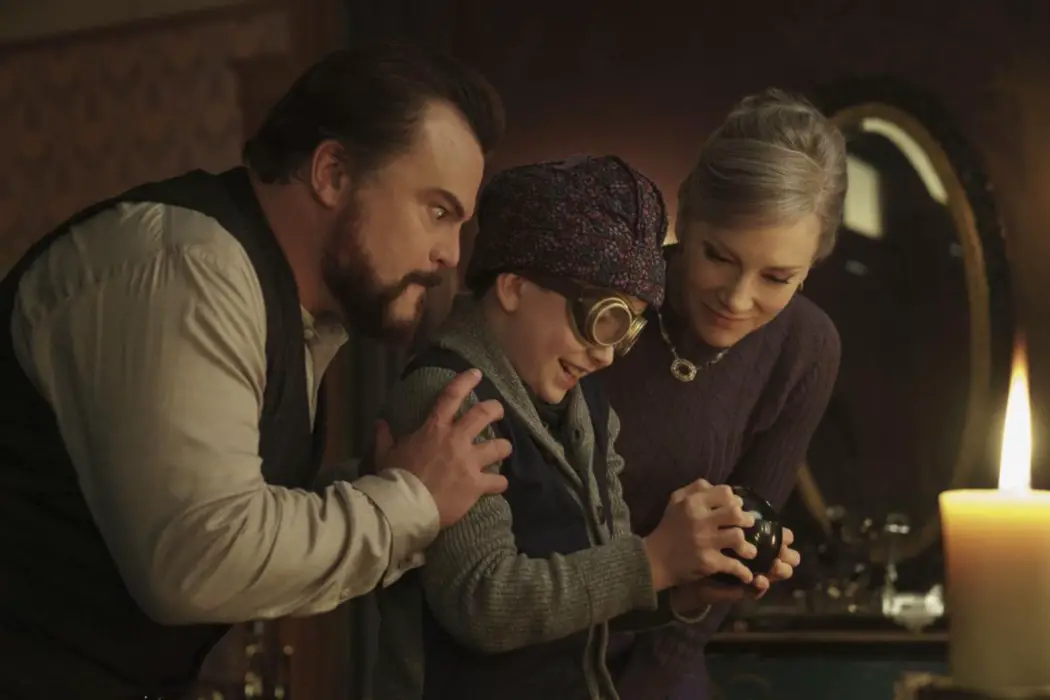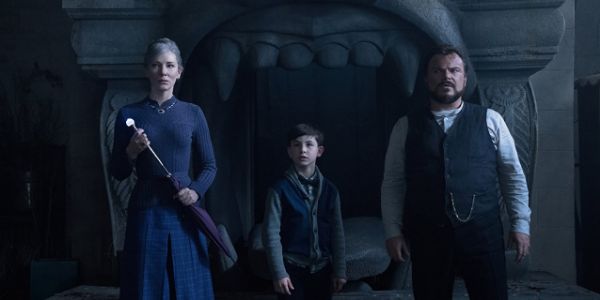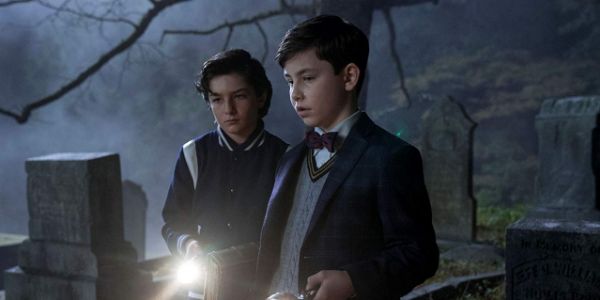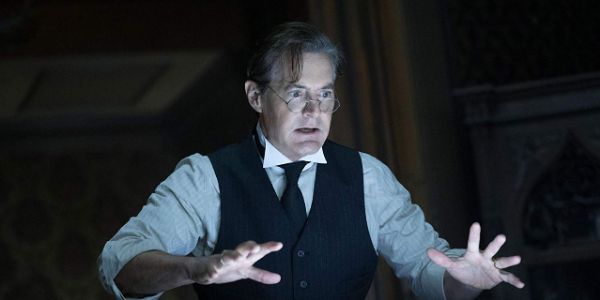THE HOUSE WITH A CLOCK IN ITS WALLS: Retro Fun With A Dash Of Creepiness

I'm a student at the University of North Carolina at…
The House with a Clock in Its Walls is far from a slam dunk, but man do I wish we had more movies like it. This is just a nice little slice of escapism, one that delivers old-fashioned entertainment for a couple hours, complete with the requisite scares and laughs that define this particular sub-genre. It’s not part of a franchise, nor does it seem to have any real aspirations for a sequel. It’s nostalgic for a different era of filmmaking, but it doesn’t rely on that nostalgia to a debilitating extent. It’s popcorn fluff, and yet there’s actually a message under the surface.
To summarize, director Eli Roth has just made a solid film. Nothing you’ll remember in five months, but perfectly pleasant for a breezy fall afternoon. The haunted house thriller drags its feet on occasion, often suffering from anti-climatic moments and a somewhat surprising lack of practicality in the effects department (the whole thing has a slightly plastic-y feel to it). But Roth, the frequent Tarantino collaborator and shock horror maestro, keeps it all together in the family chiller realm, crafting the type of delightfully creepy funhouse charms that should entertain a wide spectrum of viewers.
Warlocks & Witches & Magic, Oh My!
The story begins in the 1950s in New Zebedee, Michigan, where young Lewis Barnavelt (Owen Vaccaro) is preparing to reset his life after an enormous tragedy. His parents both died in a car accident, so Lewis is sent to live with his Uncle Jonathan (Jack Black). One cross-country bus ride later, and Lewis has arrived in a place that’s undeniably peculiar. First, there’s the appearance and demeanor of Uncle Jonathan. He claims that his house has no rules, and he strolls around town in a flashy kimono like he doesn’t have a care in the world.

And then there’s the house itself, which seems like it was ripped out of a horror novel. Things don’t get any better when Lewis goes to school. Not only is he treated poorly by classmates thanks to his oversized goggles and know-it-all attitude, but new acquaintance Tarby Corrigan (Sunny Suljic) also tells him that his house is definitely haunted. After Lewis spots Uncle Jonathan wandering the mansion late at night, the jolly fellow is forced to spill the beans – he’s actually a warlock. Once Lewis understands that warlocks are more than just “boy witches,” he practically begs his uncle to teach him everything. It only takes some light pleading for Jonathan to agree.
With the help of Florence Zimmerman (Cate Blanchett), Jonathan’s neighbor and a fellow master of the magical arts, Lewis works and trains to become a powerful warlock. But all is far from well in New Zebedee. There’s a hidden clock in the walls of the Barnavelt mansion, and it was put there by Isaac Izard (Kyle MacLachlan), a wicked warlock and Jonathan’s former friend. Isaac is dead now, but he could be plotting his return from beyond the grave. As Lewis is tested and tempted to learn the arts of dark magic, Isaac’s threat grows, potentially setting in motion an apocalyptic event that could threaten the universe.
Spooky Delights In A Nostalgic Chiller
With the presence of both a retro Universal logo and the iconic Amblin symbol before the credits, it’s easy to understand why The House with a Clock in Its Walls is practically destined to be seen as some kind of Spielbergian throwback film. Plus, it has many of the necessary elements for the classic Spielberg story, from the tortured young protagonist to the presence of a hero’s journey into the spectacular land of the unknown.

I won’t dispute that Roth‘s film is something of a throwback to a bygone era; it embraces both candy-colored mid-1950s aesthetics and the filmmaking tendencies of the 1980s. But House with a Clock has more in common with early Tim Burton movies (think a less overtly comedic Beetlejuice and a less explicitly tragic Edward Scissorhands) than it does with the sentimental Spielberg framework, opting for mild scares and an extravagant exploration of the macabre over anything resembling grounded terror. The film shares Burton‘s love for outsiders and a knack flights of fantastical weirdness, though I wouldn’t go so far as to say that it’s some kind of homage.
I say that because, contrary to what many others have professed, this is still very much a film for kids. Though I’m not a parent, there’s only one real scene that I would even consider to be potentially unsettling. For the most part, House with a Clock is content to conjure up the mildest of scares, often dissipating its tension with a well-timed joke or two. Roth‘s goal is not to terrify his audience, but to create a spooky atmosphere that is both gleefully creepy and unambiguously playful, even if the film’s visual sheen sometimes undercuts the mood.
The Bonds Of Trauma
Beyond the film’s channeling of a variety of nostalgic styles, perhaps the most interesting thing about The House with a Clock in Its Walls is its exploration of grief and trauma, which serves as a potentially unconscious dissection of a trope that we’ve seen more and more in recent arthouse horror movies. Whenever a new chiller takes the festival circuit by storm, it’s almost a guarantee that this argument will arise, and it has encompassed everything from Jennifer Kent’s The Babadook to Ari Aster’s Hereditary over the past few years.
Even though it’s a thematically sound take in nearly every instance, we’ve reached a point where I almost instinctively roll my eyes whenever I hear someone say, “Well, it isn’t really a horror movie; it’s actually about trauma.”

So as much as I hate to be the guy making this argument about another scary movie, it’s undeniable that Roth and screenwriter Eric Kripke are dabbling in this arena. To start, every character of major importance in the film has experienced something terrible, either on a personal or global scale. Lewis lost his parents at a very young age, and he’s still a long way from getting over that tragedy. Florence lost her husband and daughter in a way that has shaken her completely. Isaac witnessed the horrors of World War II. Jonathan had a falling out with his family, and then he lost his best friend to the dark side of magic.
With that in mind, The House with a Clock in Its Walls becomes a film about how we process loss, and how that pain can take us down both positive and negative roads. Even if it’s sort of a cliché to deal with an orphan protagonist in this kind of story, Roth and Kripke add a level of poignancy to Lewis’ heroic tale, as his growth as a warlock is measured against a tangible choice between two paths. I’m admittedly unfamiliar with the source material by John Bellairs, so I can’t say if this is a new addition or a feature of the book, but I was genuinely impressed by the film’s emotional depth.
The House with a Clock in Its Walls: Conclusion
Yet despite its impressive strength in the thematic department, I should emphasize that The House with a Clock in Its Walls is, almost by design, a relatively disposable film. The story plays out much like you’d expect, and the presence of Jack Black and Cate Blanchett does little to elevate the impact of the material. Roth struggles with pacing from time to time, often moving the story along in fits and starts without really settling into a consistent groove.
Still, there’s a sense of mischievous fun in play here, with a hearty serving of chills and chuckles to overwhelm any shortcomings that may hinder the film’s quest for nostalgic perfection. Roth clearly enjoys twisting the trappings of the haunted house genre, and there’s just enough under the surface to keep things interesting for those not scared by what goes bump in the night. Simply put, it’s a welcome throwback in an age where this kind of film is something of a rarity.
What did you think of The House with a Clock in Its Walls? What is your favorite old-school Amblin movie? Let us know in the comments below!
The House with a Clock in Its Walls was released on September 21 in the U.S. and the U.K. For full international release information, click here.
Does content like this matter to you?
Become a Member and support film journalism. Unlock access to all of Film Inquiry`s great articles. Join a community of like-minded readers who are passionate about cinema - get access to our private members Network, give back to independent filmmakers, and more.
I'm a student at the University of North Carolina at Chapel Hill. For 8 years, I've edited the blog Martin on Movies. This is where I review new releases, cover new trailers, and discuss important news in the entertainment industry. Some of my favorite movies- Casablanca, Inception, Singin' in the Rain, 2001: A Space Odyssey, The Wolf of Wall Street, The Nice Guys, La La Land, Airplane!, Skyfall, Raiders of the Lost Ark. You can find my other reviews and articles at Martin on Movies (http://martinonmovies.blogspot.com/).













